|
Airfix 1/48 scale
Spitfire Mk.IXc / XVIe

S
u m m a r y
|
| Description and Catalogue Number: |
Airfix Kit # 05113 - Supermarine
Spitfire Mk.IXc / XVIe |
| Scale: |
1/48 |
| Contents and Media: |
70+ parts in grey
injection molded plastic; six parts in clear; markings for three
aircraft |
| Price: |
£10.99
available online from Hannants |
| Review Type: |
FirstLook |
| Advantages: |
Accurate in outline, profile and
dimensions; fine recessed surface detail (especially panel lines on new
fuselage and wings); many useful options including armament, wheels,
wing tips and top engine cowling; plenty of spare parts including an
entire MkVc wing(!); good quality decals; nice cockpit detail; pilot
figure included. |
| Disadvantages: |
Clear parts a bit thick; poorly
shaped propeller blades; marginal shapes in some detail areas; thick
wing; wide, soft fabric surface detail. |
| Recommendation: |
Recommended. |
Reviewed by Brett Green
The search for a perfect 1/48 scale Spitfire Mk.VIII / IX / XVI has been
a bit like the quest for the Holy Grail. Every time modellers get a whiff,
that perfect Spitfire just recedes into the mist again.
Hopes were high for the Ocidental offering, but that kit had some serious
dimensional and cross-section problems. The ICM 1/48 scale Spitfire IX
was more accurate, but early pressings were plagued with moulding flaws and
the fuselage was a bit skinny in any case. Over-engineering also made this
kit a challenge to build. Hasegawa's 1/48 scale Spitfires are beautifully
detailed, but the whole family is blighted with a noticeably short fuselage
and related detail issues.
It is as if this great aviation icon is cursed.
Airfix is the latest company to take their chances with the most-produced
of all Spitfire variants. So, have we finally found that elusive plastic
counterpart to the Holy Grail?
Airfix has released an almost all-new kit with their 1/48 scale
Spitfire Mk.IXc / XVIe. The new parts include the entire fuselage, an
all-new wing, and the specific details relating to late Merlin Spitfires.
In total, there are more than 70 parts in grey injection-moulded styrene on
nine sprues.
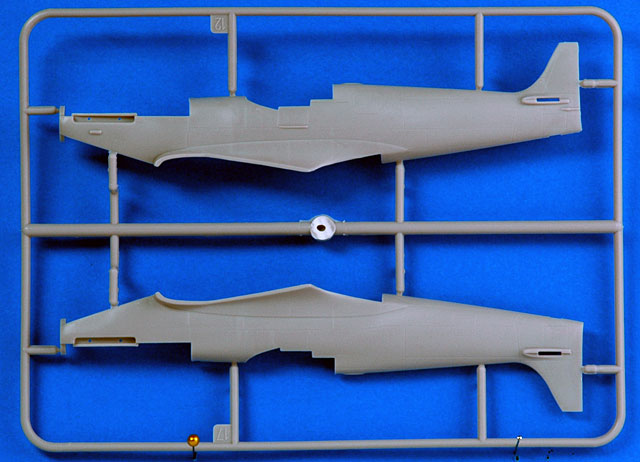
Click the thumbnails below to view
larger images:
The new parts are especially well done. Panel lines are crisply recessed and
very fine, supplemented with subtle rivet and fastener detail in places. The
texture of the new parts is satin - certainly not the egg-shell finish that
we have seen on some recent Airfix mouldings. There are only a couple of
minor sink marks that I can see on my sample. These are on the starboard
side of the fuselage under the canopy, and will be quickly dispatched with
putty and a sanding stick. The only other moulding eccentricity is the
massive sprue connectors on the wing parts.
It is a great relief to find that the general outline of the airframe, and
the overall dimensions, correspond with respected plans. The shape of this
Spitfire is basically accurate.
So, what can we build from the parts in the box?
Airfix supplies us with a standard "razorback" fuselage, plus a late
elliptical wing. In addition to this basic canvas, Airfix offers two styles
of upper cowl (early "flat" style and the later bulged version, usually seen
covering Packard Merlins), three varieties of separate wing tips (standard,
clipped LF and the pointed HF versions), and three versions of wing gun
covers (standard two-gun C, four gun C, and E). Only the flared style of
exhausts are in the box. Two wheel patterns are included though - four spoke
and covered, both with smooth treaded tyres. Elevators are the late "kinked"
style only, and the supercharger intake under the nose is also the late
style. Early (rounded) and late (pointy) rudders are also included.
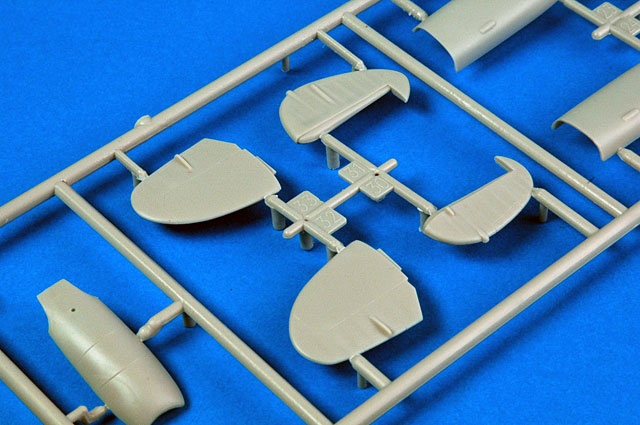
Taking all these options into account, we can build any razorback Spitfire
IX or XVI straight from the box except the early production Mk.IX. And even
if you do want to build an early Mk.IXc from, say, 1943, you will
only have to rescribe the elevator hinge line and modify the supercharger
intake.
Airfix has also provided separate flaps. Keep in mind, though, that the
flaps were either full up or full down, and it was rare to see flaps down
when the Spitfire was parked.
The cockpit and wheel wells are quite good. A few prominent features
such as the oxygen regulator, oxygen hose and some wheels and boxes are
missing, but they will be very easy to add from scrap plastic and wire if
you feel so inclined. The seat looks good too, although it does appear
somewhat oversize.
Detail is a little half-hearted on the exhausts and inside the radiator
where there is no facing detail. Airfix has also not quite nailed the shape
of the narrow wing cannon bulges. In addition, the trailing edges of the
elevators and rudders are quite thick, the fabric texture is soft, and the
trim actuators are chunky and simplified.
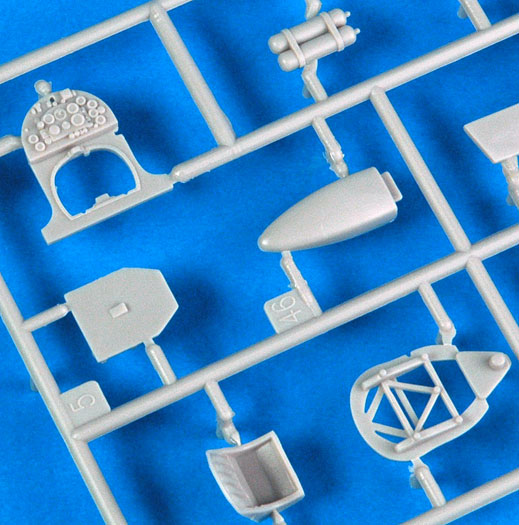
Click the thumbnails below to view
larger images:
The most noticeable problem, however, is the shape of the propeller blades,
which are pretty bad. The profile is more suggestive of a bread knife than a
propeller blade.
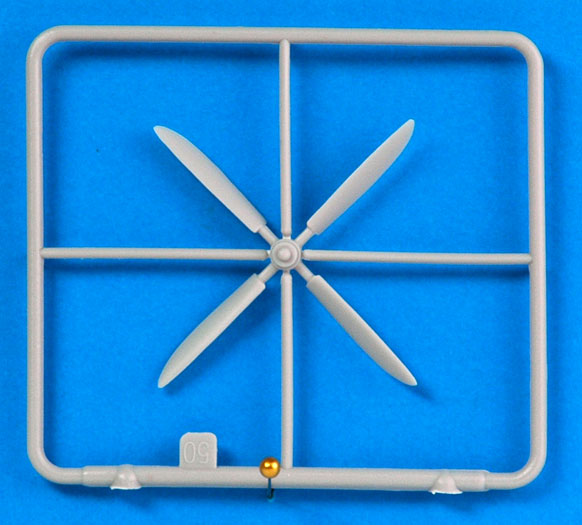
At the very least, the modeller should reshape the leading edge to obtain a
curve leading toward the propeller tip. Ideally though, the propeller blades
should be replaced. The shape of the spinner is a bit too pointy, but this
problem is nowhere near as critical as the blades. Fortunately, both
Aeroclub and Ultracast offer replacement propeller blades and spinners for
late-Merlin Spitfires. Although neither is designed for the Airfix kit, I
have checked both replacement units against the Airfix fuselage and it
should be fairly simple to adapt them to the job.
The six clear parts are very clean, but a bit on the thick side.
Interestingly, although not discussed in the instructions, two alternate
parts are supplied for the small aft canopy section. One is taller than the
other. I assume the short one should be used when the sliding section is
fixed open (allowing clearance from the thick plastic). The taller one would
be used if the canopy was glued shut.

Test fitting indicates that the wing is quite thick overall. This will be
most noticeable when viewed directly in front. The aileron trailing edges
can be easily thinned with a few swipes with a sanding stick. If the flaps
are secured in the dropped position, you will limit the visual impact of the
thick wing.
Markings are supplied for three aircraft. The decals are very good - high
gloss and in perfect register. The only wrinkle is the Sky codes and
fuselage band. The Sky colour has been printed using a dot-screen process
and, viewed close up, you can see the dots.
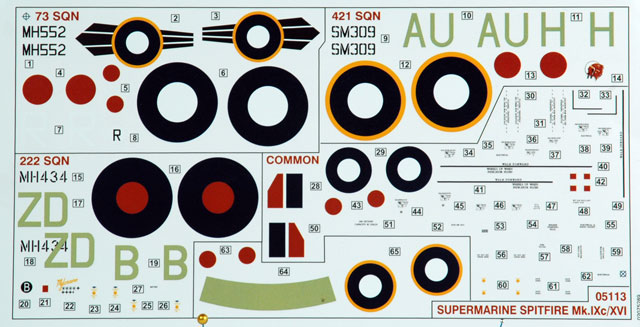
In addition to the Mk.IX / XVI kit contents, Airfix has included a "bonus"
Mk.Vc wing. Although its inclusion is a bit odd (the separately sprued parts
cannot be used on this variant), it is nevertheless welcome. Maybe a cross
kitting with a Tamiya Mk.Vb to deliver a Spitfire Vc?
I think that modellers have to accept that we may never see
the late-Merlin Spitfire Holy Grail materialise in 1/48 scale, but the
Airfix Mk.IX / XVI does have its good points.
The new Airfix Spitfire Mk.IXc / XVIe is a decent model with
accurate dimensions, nice surface detail and plenty of useful options. The
kit's problem areas are irksome, but most are addressable.
With a replacement propeller assembly, some attention to
trailing edges and perhaps a vacform canopy, the Airfix Spitfire will be an
attractive addition to your collection. It will be more accurate in outline
than the Hasegawa and Ocidental offerings, and should be easier to build
than ICM.
At around £10.99, it represents pretty good value too.
Recommended.
Thanks to Hannants for the review sample.
Text and Images Copyright © 2006 by
Brett Green
Page Created 21 March, 2006
Last updated 21 March, 2006
Back to HyperScale Main Page

Airfix's 1/48 scale Spitfire IX / XVI will be available online from Squadron.com
|
Home | What's
New | Features
| Gallery |
Reviews | Reference
| Forum
| Search